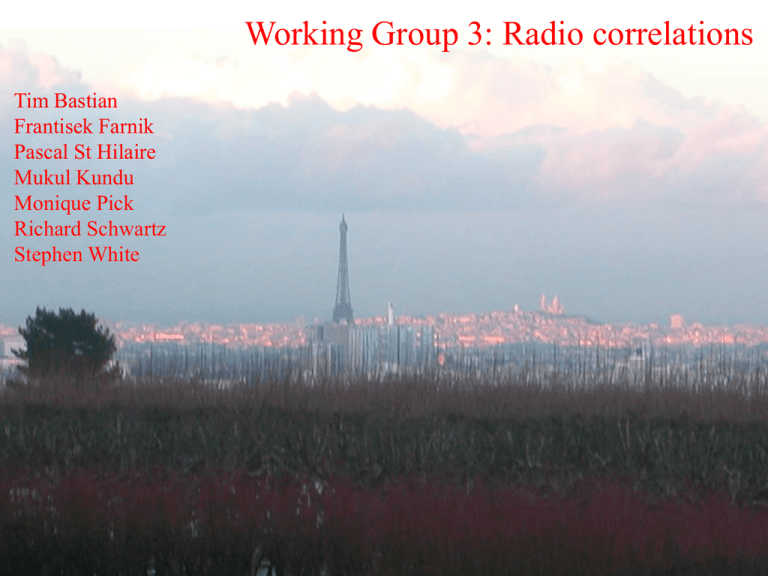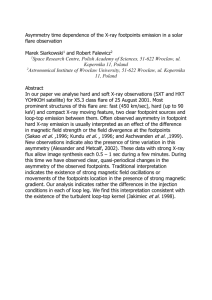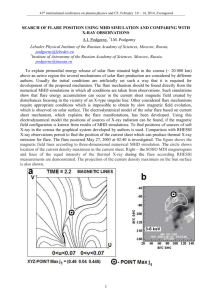Working Group 3: Radio correlations Tim Bastian Frantisek Farnik Pascal St Hilaire
advertisement

Working Group 3: Radio correlations Tim Bastian Frantisek Farnik Pascal St Hilaire Mukul Kundu Monique Pick Richard Schwartz Stephen White 24 Oct 2001 A Cool, Dense Flare T. S. Bastian1, G. Fleishman1,2, D. E. Gary3 1National 2Ioffe 3New Radio Astronomy Observatory Institute for Physics and Technology Jersey Institute of Technology, Owens Valley Solar Array Observational Summary • Impulsive, radio rich flare – little EUV, SXR, HXR • Low frequency cut-off below ~10 GHz • Flux maxima delayed with decreasing frequency • Flux decay approx. frequency independent late in event Interpretation • Radio emission is due to GS emission from non-thermal distribution of electrons in relatively cool, dense plasma • Ambient plasma density is high – therefore, Razin suppression is relevant • Thermal free-free absorption is also important (~n2T-3/2n-2) Include these ingredients in the source function (cf. Ramaty & Petrosian 1972) The idea is that energy loss by fast electrons heats the ambient plasma, reducing the free-free opacity with time, thereby accounting for the reverse delay structure. 1 spectrum/ 2 sec 2-parameter fits via c2minimization nrl, T B, q, nth, A, L, E1, E2, d fixed Microwave and hard X-ray imaging observations of energetic electrons in solar flares: event of 2003 June 17 Kundu, M R., Schmahl, E J, and White, S M i RHESSI light curves (12-800 keV) and radio time profiles Selected RHESSI 12-25 & 25-50 keV maps in different epochs of the main phase 12-25 keV 25-50 keV 12-25 keV 25-50 keV Fig 8a RHESSI 200-400 keV Image along with lower energy maps Note that the low energy and high energy sources are co-located Fig 8b Selected 17 GHz maps in I and V at different epochs of the main phase Note appearance of oppositely polarized source at ~2246 –- first maximum. Intensity Fig 10a Polarization HXR & 17 GHz I HXR (contours at 10,30,..,90%) & 17 GHz I (color) Note coincidence of HXR & 17 GHz flaring sources Fig 12b SUMMARY AND CONCLUDING REMARKS • We discuss a flare of GOES class M6.8 using simultaneous imaging observations by RHESSI in HXR and by NoRH in microwaves. • The preflare phase was observed well by RHESSI, but not by NoRH due to Nobeyama night time. The important feature of the RHESSI preflare phase is that we observed a TRACE ejecta whose height- time positions were well determined. The trajectory of the absorbing material tracks directly from a 6-25 keV "looptop" source, consistent with the scenario that open field lines extend above a reconnection region near the top of the flare loop, and that material--possibly a plasmoid--is ejected upward from that region. • Shortly after the ejection, accelerated electrons are beamed downwards from that reconnection region to the footpoints where they appear in hard X-rays with energies > 25 keV. Coronal connectivity from radio and hard X-ray images Stephen White Coronal connectivity • Due to limited dynamic range, generally assume that one HXR source is a footpoint, two is 2 footpoints, three is 2 footpoints plus loop top: “single-loop paradigm”. Compare soft and hard energy ranges. • Radio data have more dynamic range and we generally see several sources, even in quite small events • This offers the opportunity to help with identification of coronal connections of RHESSI sources • Strongest evidence is correlated fluctuations in connected sources flare flare flare flare flare 2003 Nov 3 flare: 17 + 34 GHz + 12-25 keV 25-50 keV images look like 12-25 keV 2003 Nov 3 flare Joint Discussion: WG2 and WG3 The High Frequency Radio Component in Large Flares Gerard Trottet: millimeter data, interpretations Ron Murphy: high-energy pions Tim Bastian: possibility of a thermal explanation OVSA 4 November 2003 SST 405 GHz SST 212 GHz 3300 Largest SXR flare recorded: X28, possibly as large as X45 (Neil et al. 2004, Burton et al 2005). Kaufmann et al. 2004 Increasing spectra above 200 GHz ? • Optically thick gs. From e- compact and very dense sources with high magnetic field: unrealistic numbers of high energy electrons! • gs. from positrons (Lingenfelter & Ramaty 1967) • Inverse Compton/gs (Kaufmann et al. 1986) • Thermal: optically thick free-free emission: energy deposition in the chromosphere by particles or conduction fronts Example of gs from positrons (Lingenfelter & Ramaty 1967) SST 200 MeV 50 MeV TIR B=400 G B The submm-l source is manifestly composed of contributions from several sources: • The SXR-emitting plasma must contribute at least 2000 sfu to each of 212 and 405 GHz • There is clearly a nonthermal component, estimated to be of order 3300 sfu at 212 GHz and perhaps 1500 sfu at 405 GHz • The bulk of the remainder could be accounted for by the sum of optically thick and optically thin contributions of material at temperatures from TR to SXR-emitting values. Sn 2k B n2 c2 d T e eff d 2kB source 0 n2 c2 i T ( 1 e ) i i i Electrons going both up and down from energy release site Radio bursts and CME’s Monique Pick RHESSI workshop 5-8 April 2006 17 March 2002 Y. Yan, M. Pick, M. Wang, S. Krucker, A. Vourlidas RHESSI NRH OSRA DAM WAVES 17 March 2002 RHESSI HXR SXR West source + polarity East and middle sources mixed polarity Outline 2 adjacent loops 3 HXR sources at foot points 17 March 2002 Event B Continuum O Type III’s 236 MHz Cadence 1s 600 km/s 17 March 2002 Event B AR 9871 inside old remnant region Inclusion of small interacting loops CME above large extrapolated S loops HXR West source + polarity East and middle sources mixed polarity SXR Outline 2 adjacent loops « W » shape HXR and Radio: Temporal relationship Sprangle &Vlahos, 1993 EM excited by unstable electron distribution inside the flaring loop and excite electrons along Open fields. 17 March 2002 HXR and Type III same electron population Small loops emerge(1 or 2) interact with surrounding open field lines HXR produced by electrons propagating downward Outward electron beams propagate in the interface region between the ascending CME and the neighboring open field lines Development of CME this region becomes highly compressed TypeIII 2fp starting and ending altitudes at each frequency Apparent motions of type III bursts (4 at 164 MHz) Newkirk model increase in density 10 Search for X-ray emission from coronal electron beams associated with type III radio bursts Pascal Saint-Hilaire, Säm Krucker, Robert P. Lin Space Sciences Laboratory, University of California, Berkeley Sixth RHESSI Workshop Meudon, April 5th, 2006 Standard flare scenario: Type III X-rays ??? Reconnection, Particle acceleration I(ε) ε Observed photon spectrum Model: Upward beam propagates in a barometric 2MK corona… Start density: N0= 5x109 cm-3 X-rays F0(E) E d=4 Eco=10 keV Nelectrons=2.7x1036 e-/s Injected electron spectrum X-rays Combined, symmetric downward and upward beam: Acceleration region Need flares with occulted footpoints! N0=5x109 cm-3, d=4, Eco=10 keV, Nbeam=2.7x1036 electrons/s, dt=4s d=7 ( elongated structure less obvious) Summary 1: Modeling • Flare-like “upwards-going” coronal electron beams should be observable • Coronal beam heating due to beam only observable when local densities are high (1011 cm-3) • Best candidates are occulted flares ( limb) • At limb, elongated structures are expected (best: small d) Observations: • Start point: list of decimetric radio bursts from Phoenix-2 spectrometer (ETH Zurich) • 867 type III bursts between RHESSI launch and June 2005. • 326 were also observed by RHESSI, with attenuator state 0. • Take the ones that have X-ray sources above the solar limb 29 candidates Conclusion so far… • No clear Type IIIs associated with limbic electron beams propagating outwards (using X-rays as proxy) have been found so far. Statistically, a few were expected. Will use NRH 900ms data… • RHESSI imaging requires ~1035 electrons/s • For detection, about 5x1033 electrons/s [above 10 keV] are needed. Just the fact that Type IIIs and HXR lightcurves are *rarely* time-correlated means we rarely have that many electrons in the Type IIIproducing beam… • In agreement with previous estimations: interplanetary Type III-emitting electron beams contain only ~1031 electrons/s (Lin, 1973) : product of a (secondary) reconnection process higher up in the corona? Two (simultaneous) reconnection sites? 2: Secondary reconnection site: ~1031 electrons/s 1: Main energy release site (main driver): 1035-36 electrons/s Benz et al., 2005 Reverse Drift Bursts in the 0.8-4.5 GHz Band and their Relation to X-Rays František Fárník and Marian Karlický Astronomical Institute Academy of Sciences 251 65 Ondřejov Czech Republic ffarnik@asu.cas.cz karlicky@asu.cas.cz First example of an event with a single well defined “fast” RDB on 27 May 02 Typical features of many events in our data set: * very weak hard X-ray emission, short and nearly symmetrical profile * compact hard X-ray source * soft X-ray importance C * high frequency drift * RDBs during the rise phase in RHESSI flux * RDBs are nearly always observed during the hard X-ray burst but it seems to be impossible to make a reliable temporal correlation of an RDB and a sub-peak in the X-ray flux A few other examples: 31 AUGUST 2002 01 AUGUST 2005 CONCLUSIONS • Reverse Drift Bursts are mostly observed during the rise (flash) phase of hard X-ray emission. • In the frequency range below 1.4 GHz Aschwanden et al. found in 26 % of studied 882 events correspondence between individual X-ray peaks and type III radio bursts (including RDBs). The relative timing between HXR pulses and radio bursts was found with a coincidence of <0.1 s in statistical average. In the range above 1 GHz we did not find any such one-toone relation between individual X-ray peaks (sub-peaks) and individual RDBs on the time scale of the order of 1 s. Fin 2002 July 23: TRACE 195 A movie 2002 July 23: Nobeyama Radioheliograph 17 GHz movie HESSI Radio Group: Scientific Issues • Relationship of microwave source morphology to RHESSI morphology • Relationship of radio spectral index to HXR power law: is this only possible for high-energy HXR? • Multiple spike events: are all the spikes coincident? Double/footpoints? • Energy releases: do we see the hard X-ray releases in the decimeter range? In the metric range? • Can we compare the energy spectral indices for two footpoints separately in radio and HXR? • Using decimeter bursts from RHESSI-identified behind-the-limb sources to infer density-height distribution Radio Group: Presentations • Occulted flares (joint with Krucker in WG4) – Laura Bone • Short millimeter wavelength observations (joint with Trottet in WG2) – Adriana Silva: SSRT observations – Separately: possibly also Stephen White in group on BIMA events • The relationship between spectral features and hard X-rays: – Frantisek Farnik: reverse drift bursts – Guangli Huang: discrepancies between microwaves and hard X-rays – Ludwig Klein: accelerated electrons, shocks and CMEs • Microwave imaging studies: – Weiqun Gan: shrinkage of flare loops – Mukul Kundu: microwaves and HXR from several flares – Stephen White: when is a loop not a loop? Working Group 3: Radio correlations



